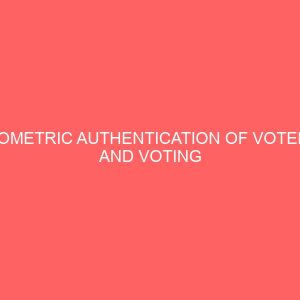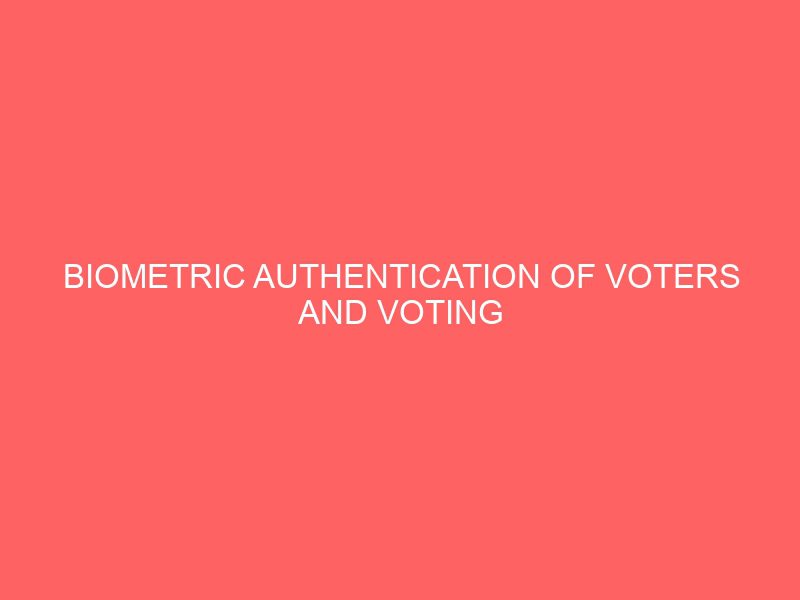Description
CHAPTER ONE
1.0 Introduction
This project is on Bio Metric Authentication of Voters and Voting Process a Study of Senatorial Election. Previously, voting for general and local elections is done by electors with voting papers and voting boxes in which the voting papers are placed. This method reveals some kinds of negative situations. Not been able to determine which party the stamp belongs to, the probability of placing the voting papers in wrong box, problems with counting the votes, loss of time when there happens to be some objections, paper printing and expenditures done for personnel are some of the disadvantages of classical election system. The secret ballot is a fundamental instrument for protecting the freedom of choice of voters. For this reason, it is necessary to use new technologies for making the election system more trustable, economic and faster.
Electronic election system is set into use in some countries, especially in USA and Europe, at the beginning of nineties as a result of innovating technology and it became more trustable by improving itself at the present day. Electronic voting is an activity of realizing the voting in electronic environment. Electronic election is a system which enables fast counting by electronic voting.
Electronic voting is used in some countries in the world and there are also studies about it Babu and Padmavathamma, 2006; Elqawasmeh and Owais, 2010;
Folorunso et al., 2005; Hajjar et al., 2006. Electronic voting is used for parliamentary elections in Australia in 2001 Schoen and Faas, 2005, for student union elections in Austria in 2003 Prosser et al., 2003, for municipal elections in Canada in 2003 Nakhaie, 2006, for both general and local elections in India in 2003 Gorla, 2009. As a result of developments on information technologies in recent years, public opinion polls and nationwide general elections will be realized faster and more effectively on electronic environment.
Nowadays, security problems are experienced with the fast developing technology. Besides developing the system, there are also so many studies and new methods for solving the security problems of the developing system. As a result of developing technology, individual password is started to be used to meet the security requirements. In time, new methods are developed and card technologies are used due to closing the security holes about burglary of the cards or forgetting the individual passwords. Usage of the ID cards and Private Identification Numbers PIN become widespread at card technologies Sonkamble et al., 2010; Alkan and Bulut, 2010. Researches on security and identification operations according to physical characteristics are realized due to limitations of this technology in time.
Biometric systems are the methods which make identification of people according to their physical characteristics. Biometric methods consist of fingerprint, face, hand shape, retina, iris, and voice track methods Sonkamble et al., 2010; Kadry and Smaili, 2010; Razzak et al., 2010. These methods may be used alone or together in the developed systems.
Fingerprint recognition method and ID system in biometric methods are frequently preferred because applications of them are easy and low-cost Maltoni et al., 2009. Fingerprint recognition system is the leading method because everyone has different fingerprints, can not be changed easily and probability of loosing, forgetting and stealing of it is impossible. Besides, every finger has distinctive characteristics because fingerprints of every finger of a person are different Altun et al., 2008.
For this reason, fingerprint method is used mostly alone or together with other biometric methods for providing security of the systems. Fingerprint method is also used for identification of the internet applications.
In this study, biometric authentication system is aimed instead of traditional election systems. By developing the deficiencies of the present system, biometric based election system has been developed.
1.1Background of the Study
Voting theory formally began in the 18th century and ever since, many proposal has been made towards using electronic technologies to improve elections Sobia, Ummer, Ayesha, Usman, and Hassan, 2011. One of the essential features of democracy is Election, democracy encourages individuals freedom with respect to the rule of law, so that individuals can express their opinion the way they wish, giving individuals the opportunity to decide their leaders, and uninhibitedly express their feelings on issues. Because of the Allinclusive Affirmation of Human Rights in the year 1948 that puts import on compelling circumstance of free elections, countries focused on an improved and new voting process that are of significance to the election processes in the 21st century Salomonsen, 2005.
Election is the process that enables individuals to choose their delegates and express their fellings on the way they will be administered Kohno, Rubin, Stubblefield Wallach, 2003, Malkawi, Khasawneh AlJarrah, 2009 and Ashok Ummal, 2011.
Nigerian election process has been done manually voting for local and general elections done by electors with ballot papers and ballot boxes in which the papers are placed since returned to democratic rule in the year 1999, the manual voting process was associated with a lot of problems and always resulted to postelection violence Yekini, Oyeyinka, Oludipe Lawal, 2012.
In the Federal republic of Nigeria, voting system is of two main categories, Manual Voting System MVS and Electronic Voting System EVS.
The Manual Voting System MVS involves presenting eligible citizen with a list of contestants on a paper called ballot paper, to mark against their favorite contestants and place the ballot paper in a box called ballot box, this system of voting is used for senatorial and governorship election processes in the country. Manual voting system has some disadvantages, which include possibility of placing the ballot paper in the wrong ballot box, votes counting problem, loss of time when there happens to be some objections, paper printing and expenditures done for personnel, for these reasons, it is necessary to use the new technologies to make the election system faster, economic and trustable because the trust that every vote will be tallied and recorded correctly is the foundation of a genuine democracy Ademand Metin, 2011.
The Electronic Voting System EVS involves presenting eligible citizen with a list of contestants on a computer, to select against their favorite contestants, this system of voting is used for presidential election in the country. The improvement of information and communications technologies has allow for a completely computerised election process whereby counting of vote are carried out in real time, that the results are automatically out by the end of elections day Rubin, 2002.
1.2Statement of the Problem
With advances in information and communication technology, issue of security has gone far beyond ordinary password usage. This project sought to describe the biometric authentication system, as an improved solution to the existing voting system of the Federal Republic of Nigeria. The existing system is however subjected to possible loss of card, failure to card verification, and unguaranteed voters presence at the point and time of election. Furthermore, the EVS existing system is used for the presidential election, while manual voting system of ballot paper and ballot box is used for senatorial and governorship elections.
1.3 Aim and Objectives of the Study
This project aimed at the development of a windows application for the design and implementation of a biometrics authentication system for voters and voting process, with an embedded fingerprint, for users authentication to the system.
The following are the objectives of this study:
To study the existing voting method use for election in the country for senatorial and governorship candidates in elections process.
To design a robust and secured system of voting using fingerprint biometric authentication recognition process.
To implement biometrics system form voters and voting process in the country for senatorial election.
1.4Significance of the Study
The significance of this project are to improve confidentiality, integrity and voters identification in voting process, to reduce the time and stress of conducting manual election senatorial and governorship, and to provide equal level of security at the election ground.
1.5Scope of the Study
This project is purposely designed for the Independent National Electoral Commission INEC election in the Federal Republic of Nigeria to overcome the problem of illegal activities during election, by making sure only eligible voters have access to the system, immediately outputting the results of the election, and ensuring that voters have trust in the process of election. However, this system can be extended to other electoral system with little or no modifications.
1.6 Limitations of the Study
Despite all the significance of this project, it is also subjected to some limitations, which includes the fact that its a desktop application, it cannot be used by the citizens at their convenience but has to come to the pull for the election, and only a fingerprint reader from Digital persona Inc. can be used for the enrollment and verification of user to the system.
1.7Definition of Term
EVS On line electronic voting system
EVOTING Electronic Voting
INEC Independent National Electoral Commission
EVR Electronic Voter Register
PU Polling Unit
ICT Information and communication Technology
ECIL Federal Election Commission
ES S Election systems software
VVPAT vote verifiable paper audit trails
PEB Personal Electronic Ballot
PIN Personal Identity Number
MBB Mobile Ballot Box
JBC judges Booth Controller








Reviews
There are no reviews yet.